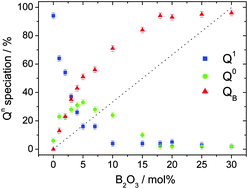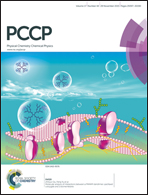Intermediate length scale organisation in tin borophosphate glasses: new insights from high field correlation NMR
Abstract
The structure of tin borophosphate glasses, considered for the development of low temperature sealing glasses or anode materials for Li-batteries, has been analysed at the intermediate length scale by a combination of high field standard and advanced 1D/2D nuclear magnetic resonance techniques. The nature and extent of B/P mixing were analysed using the 11B(31P) dipolar heteronuclear multiple quantum coherence NMR sequence and the data interpretation allowed (i) detecting the presence and analysing the nature of the B–O–P linkages, (ii) re-interpreting the 1D 31P spectra and (iii) extracting the proportion of P connected to borate species. Interaction between the different borate species was analysed using the 11B double quantum–simple quantum experiment to (i) investigate the presence and nature of the B–O–B linkage, (ii) assign the different borate species observed all along the composition line and (iii) monitor the borate network formation. In addition, 119Sn static NMR was used to investigate the evolution of the chemical environment of the tin polyhedra. Altogether, the set of data allowed determining the structural units constituting the glass network and quantifying the extent of B/P mixing. The structural data were then used to explain the non-linear and unusual evolution of the glass transition temperature.


 Please wait while we load your content...
Please wait while we load your content...